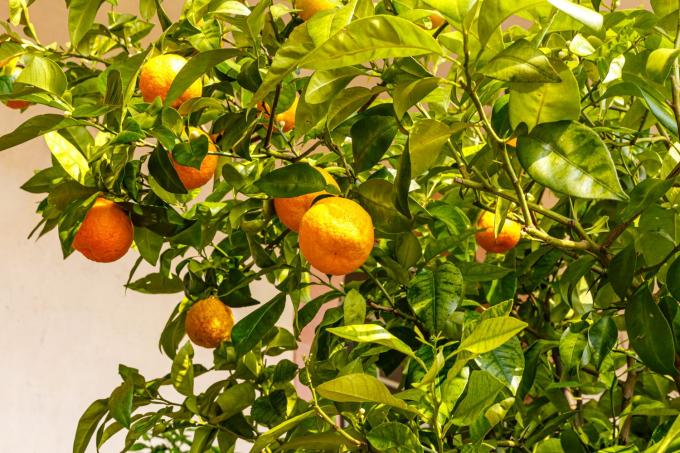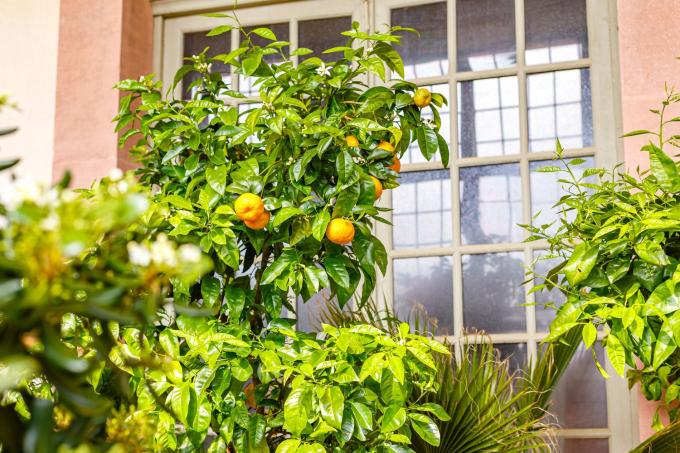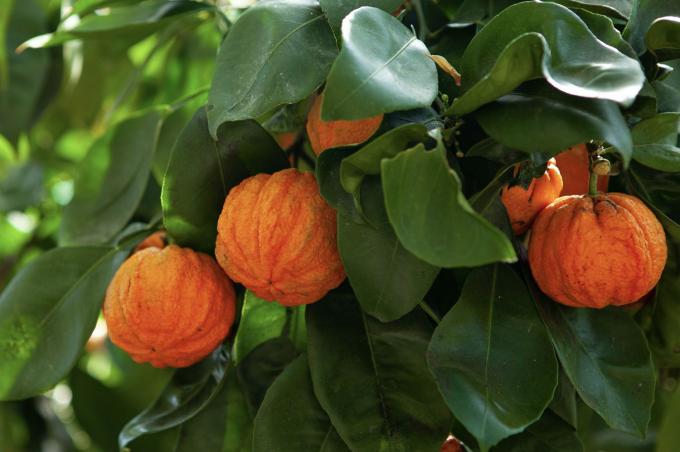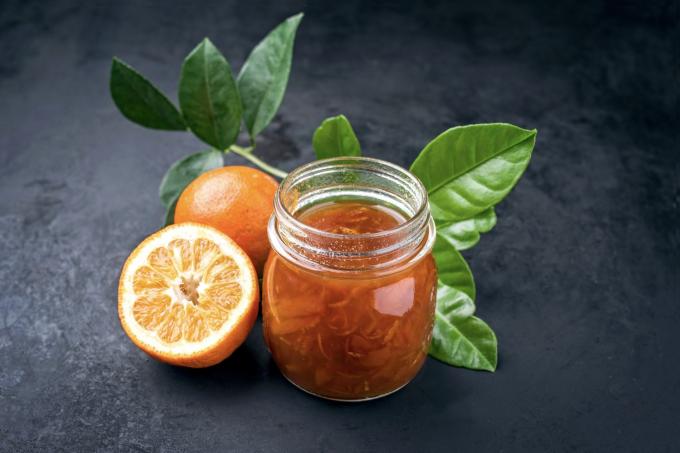The bitter orange, also called bitter orange or Seville orange, is a hybrid citrus plant. Below are tips on growing, caring for and using the exotic plant.

Exotic citrus plants are very popular in this country. But while lemons and oranges are increasingly cultivated, bitter oranges are rarely found. Here you will find a short profile of the special plant, as well as some tips on cultivation, proper care and use of the bright orange fruits.
"Contents"
- Bitter orange: flower, origin and properties
- The variety of bitter orange varieties
- Plant bitter orange: Here's how
-
Care of the bitter orange
- Pour and fertilize the bitter orange
- Cutting measures in the bitter orange
- Bitter orange does not bloom: what to do?
- Grow bitter orange
- Is the bitter orange hardy?
- Harvesting and using bitter oranges
Bitter orange: flower, origin and properties
The bitter orange (citrus x aurantium) is a hybrid of the pomelo (
Citrus maxima) and the tangerine (Citrus reticulata), which since 10. Century in the Mediterranean is cultivated. The evergreen plant probably originated in the tropical Himalayan region in southern China, from where it was brought to Italy. Some people also know them under the names Pomeranze, Seville Orange or Sour Orange. It belongs to the genus of citrus fruits (citrus) and thus to the rue family (Rutaceae).If the climatic conditions are right for the heat-loving bitter orange, it can grow into a tree up to 10 meters high. Depending on the variety, the forks of older branches may have thin, short thorns. Younger branches usually have long thorns. The leaves of the bitter orange are rich green, oval in shape and form a 2 to 3 cm long petiole. A special feature of the leaves are the oil glands, from which the pleasantly scented essential oil petitgrain is released.
The white flowers of the bitter orange have a strong scent and are mainly formed between May and June. It is not uncommon for the flowers to be formed over the rest of the year, so that flowers and fruits adorn the tree at the same time. The fruits are ready for harvest after about eight months. The fruits of the bitter orange resemble those of orange (citrus × sinensis), but are much smaller, irregularly shaped and taste bitter. When the fruits are ripe, the thick skin glows a bright orange. The pulp is very acidic compared to oranges, the white skin of the fruit tastes extremely bitter.

risk of confusion: The bitter orange can because of the homonymous name "bitter orange" with the Poncirus trifoliata (Three-leaf orange or Japanese orange) can be confused. Although both plants belong to the rue family, the bitter orange belongs to the genus citrus, while the three-leaf orange belongs to the genus Poncirus. While the bitter orange is not hardy, the deciduous trefoil orange can be overwintered outdoors. The leaves and fruits of the two plants are visually different from each other. In addition, the fruits of the three-leaf orange are inedible, in contrast to those of the bitter orange.
The variety of bitter orange varieties
There are many varieties of bitter oranges. The economically most important and popular varieties include:
- Chinotto variety group: Citrus aurantium var. myrtifolia; group of varieties used in Italy for many digestifs; mostly small, slow-growing shrubs; no spines; relatively small fruits; Varieties: 'Boxwood Leaf Chinotto', 'Crispifolia', 'Dwarf Chinotto' or 'Large Chinotto'.
- German Landsknecht pants: Citrus aurantium fasciata; since the 16th Group of varieties cultivated in Germany for centuries; produces orange fruit with light orange stripes reminiscent of "boy's trousers"; Varieties: 'Virgatum', 'Virgolare' or 'Fiamato'.
- ‘Console’: Forms a compact crown without thorns; rounder leaves and large flowers; furrowed appearance due to fruit ridges of the same colour; strong fruit set.
- ‘Salicifolia’: Narrow, willow-like leaves with an irregularly wavy margin; thornless, dense crown; evenly rounded fruits.
- ‘Foetifera’: Forms flattened fruit with daughter fruit (main fruit with second fruit included); already cultivated for a long time; sprawling growth of the tree.

Plant bitter orange: Here's how
Because of its Mediterranean origin, the bitter orange is primarily dependent on warm, dry temperatures. High humidity also increases the risk of fungal infection. Best suited for bitter oranges is a bright location without drafts, whereby direct sun is not a problem. During the warm summer, the bitter orange can be placed well in the garden, but in winter it should move to a mild winter quarters. As a container plant, the bitter orange usually does not grow higher than two meters, which makes moving between summer and winter locations a little easier.
A high-quality universal soil is suitable as a plant substrate, which is mixed with 1/3 expanded clay for better ventilation. So you can save yourself the purchase of a mostly expensive special soil. It is also important for citrus plants to use soil with a slightly acidic pH to enable healthy growth. Our Plantura organic universal soil for example, meets the requirements of citrus plants and at the same time is made without peat to protect the environment. In addition, the soil can be covered with an acidifying material such as pine bark. This maintains the soil's slightly acidic pH, protects against fungus gnat infestation, and also looks beautiful.
Since citrus plants do not like to be repotted, the opportunity should be taken to supply the plants with long-term nutrients with a reserve fertiliser. Our Plantura organic flower fertilizer in granular form offers the possibility of creating such a fertilizer depot. Thanks to its balanced NPK ratio, it strengthens the citrus plant in the long term and ensures vigorous growth of the roots, leaves and fruits.

Care of the bitter orange
If the site requirements of the bitter orange are met, it is a fairly undemanding plant that thrives with little care.
Pour and fertilize the bitter orange
During vegetation it is important to water the plant regularly as it needs a lot of water. The root ball should not dry out, but must not be exposed to waterlogging either. Bitter oranges should not be watered during the hot midday hours, as a lot of water evaporates here and does not reach the plant. It is best to water either early morning or late evening. It is important for the bitter orange to water with low-lime water, otherwise the soil pH value can increase and thus growth is affected. Collected rainwater or mineral water are suitable.
At the latest when the first leaves take on a light green color, it is time for fertilization. Yellow leaves are almost like a call for help, as this is a sign of iron deficiency. To prevent this, you should fertilize once a week with a fertilizer that is specially adapted to the needs of citrus plants. Our Plantura Organic Citrus & Mediterranean Fertilizer is excellently suited for this: It promotes vigorous plant growth and provides the bitter orange with all the important nutrients for the ripening of aromatic fruits.
Cutting measures in the bitter orange
The bitter orange should be cut back once a year to bring the plant into shape. The best time to do this is in spring, before the start of vegetation, as that is when cuts can heal best. Young plants have developed a compact crown after about 2 to 3 years. If you are not satisfied with the shape of the bitter orange tree, you can cut it back much more. The plant then begins to sprout again at the remaining branches and can be brought back into shape. Even with plants that have grown too large, this is a way of making the bitter orange a little more compact again.
Bitter orange does not bloom: what to do?
If the bitter orange does not bloom, it is usually due to overwintering that was too wet. If the plant is watered too frequently or too much in the winter quarters, the fine roots die off and the plant can be supplied with insufficient water and nutrients. If this has happened, the bitter orange should not be watered for a long time so that the root ball can dry out and new fine roots can be formed. Sometimes citrus plants can be encouraged to flower by a drought stimulus. In order to take advantage of this, you can completely do without watering after the first flowering of the year or after spring growth. If the leaves begin to droop, you should not water for another week. After that, watering can continue as normal and, with a bit of luck, the bitter orange will begin to bloom.

Grow bitter orange
One can propagate the bitter orange by the seeds contained in the fruit. The seeds can be removed from the fruit and placed in a pot of potting soil, such as ours Plantura Organic Herb & Seed Soil, are used. They should sit about an inch deep in the soil and be kept moist with repeated watering. A microclimate can then be created with a lid or cling film, which ensures rapid germination. In a warm place, the first seedlings can be seen after just a few weeks. The lid should be opened from time to time to prevent mold growth. The first flowers of the self-grown bitter orange tree will only appear after 8 to 10 years of growth, as will the first fruits.
Is the bitter orange hardy?
The bitter orange is not hardy. Temperatures down to -5 °C are tolerated for a short time, but damage the plant over a longer period of time. It should therefore move to a mild winter quarters during the cold months. It makes only few demands on the winter quarters, but it should be as bright as possible. The ideal temperature is 5 to 10 °C, but higher temperatures are also possible in correspondingly bright rooms such as a conservatory. The bitter orange should be brought to its winter quarters before the first frost. If it is constantly above 10 °C again in spring and frost-free at night, it can move back outside.
During the hibernation, the bitter orange should only be watered moderately, as if it is too wet, the fine roots will die and the plant will otherwise not bloom the next year. A finger test can be used to determine whether the soil is still moist enough or whether it needs to be watered. Fertilization is not necessary during the hibernation. More to Hibernation of citrus plants Find out in our special article.

Harvesting and using bitter oranges
Due to the change of seasons, citrus plants bloom more often in spring and summer, accordingly, the fruits ripen after eight months between November and next spring (March to March). May) off. However, the harvest is only successful if you can offer the bitter orange a warm, bright hibernation, otherwise ripening will be greatly delayed or even stopped.
The use of the bitter orange is varied, as all parts of the fruit are edible. The peel is often used to make orange peel. The famous Curacao liqueur or jam with pulp is made from the peel and juice. The juice can be drunk in the form of bitter orange soda and the flowers can be used to make orange blossom water or tea. The essential oils of the peel are part of many perfumes or serve as a room fragrance.
Are you still looking for Mediterranean fruits for your garden? Read which ones here particular types and varieties of citrus fruits there is besides the bitter orange.


